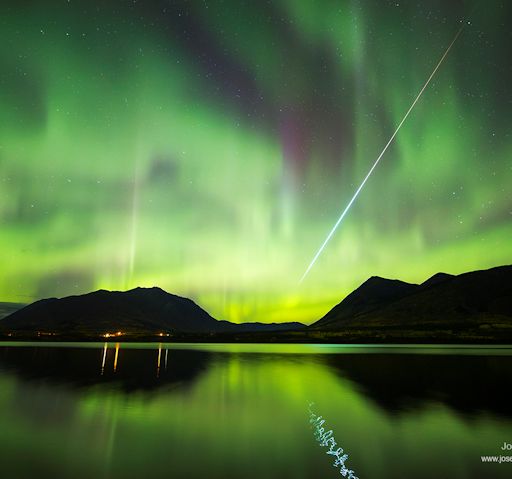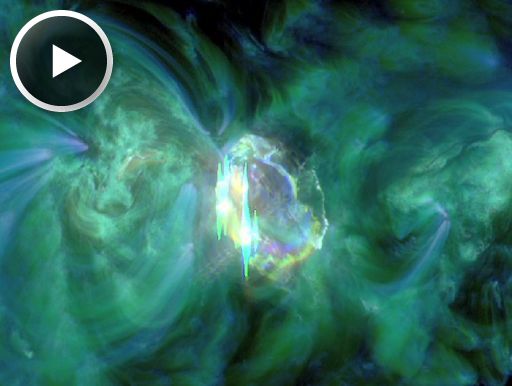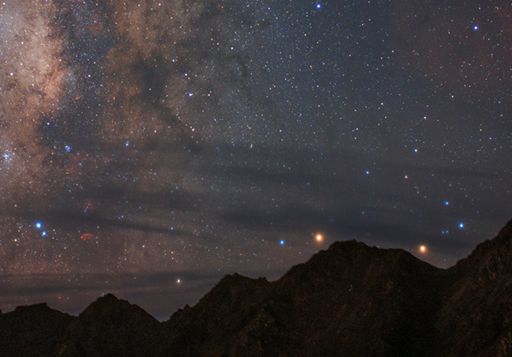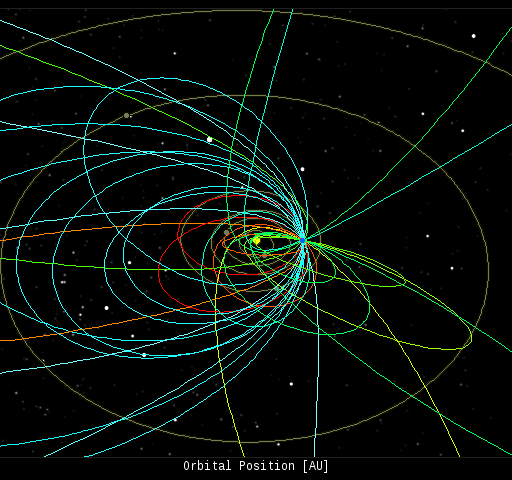When is the best time to see auroras? Where is the best place to go? And how do you photograph them? These questions and more are answered in a new book, Northern Lights - a Guide, by Pal Brekke & Fredrik Broms. | | |
CONGRATULATIONS TO INDIA: Mars is a notoriously risky planet to visit. Of 51 spacecraft sent to the Red Planet by the USA, Europe and Russia, only 21 have successfully entered orbit and/or landed. India joined that exclusive club today--and the newly spacefaring nation did it on the first try. At 7:30 AM India time on Sept. 24th, the Mars Orbiter Mission--a.k.a. "MOM"--entered orbit around Mars. Instruments onboard MOM will study the make-up of the Martian atmosphere and measure the abundance of methane, a possible marker of biological activity. Congratulations to India!
GEOMAGNETIC UNREST: Today, the interplanetary magnetic field (IMF) near Earth is tilting south, not much, but enough to open a crack in Earth's magnetosphere. Solar wind is pouring through the opening to fuel polar auroras. Among many beautiful examples in the aurora gallery, this photo gets front-page treatment because it captures a rare "fireball reflection" in the waves beneath beneath the lights:

"Northern Lights were all over the sky... then WOW! A meteor streaked through the frame," says photographer Joseph Bradley of Carcross, Yukon. "it was so bright it even cast a reflection in the water. I will never forget how beautiful it was. I thought it was going to hit the ground and at the last moment it broke up. It was a great event!"
So far, the solar wind disturbance is causing merely "geomagnetic unrest." NOAA forecasters estimate a 40% chance that a full-fledged geomagnetic storm could develop in the next 24 hours. Polar sky watchers should remain alert for auroras. Aurora alerts: text, voice
Realtime Aurora Photo Gallery
EQUINOX SOLAR FLARE: Northern autumn began with a bang, albeit only a medium-sized one. Big sunspot AR2172 erupted on Sept. 23rd at 2316 UT, producing an impulsive M2-class solar flare, shown here in a movie recorded by NASA's Solar Dynamics Observatory:

Update: Just-arriving data from SOHO coronagraphs show that the explosion did indeed produce a faint CME. Analysts are woring now to determine if the cloud has an Earth-directed component. Stay tuned.
Meanwhile, more flares are in the offing. AR2172 continues to grow and it has a 'beta-gamma' magnetic field that harbors energy for strong explosions. NOAA forcasters estimate a 30% chance of M-class flares and a 5% chance of X-flares on Sept. 24th. Solar flare alerts: text, voice
Realtime Space Weather Photo Gallery
MARS vs. ANTI-MARS: Shining bright red in the heart of the constellation Scorpius, 1st-magnitude star Antares is often mistaken for Mars. In Greek, "Antares" means "rival of Mars" or "anti-Mars," so-named because it is about the same brightness and color as the Red Planet. As September comes to a close, the rivals are converging. Jeff Dai sends this photo of Mars and Antares setting side-by-side behind Mount Balang in Sichuan, China:

"I was looking southwest in the evening sky on Sept. 20th when a conspicuous pair of ruddy objects grabbed my attention," says Dai. "Red planet Mars is moving in for a close encounter with its ancient rival, the red supergiant star Antares."
On Sept. 28th and 29th, the nights of closest approach, Mars and Antares will be only a few degrees apart, a conjunction tight enough to fit behind your outstretched palm. Sept. 29th is the best night to look because the Moon will join the display, lining up to form a near-vertical column of heavenly bodies just above the southwestern horizon. Sept. 27th is a good night, too, but for a different reason: A slender crescent Moon will pass very close to Saturn not far from Antares and Mars. Sky maps: Sept. 25, 26, 27, 28, 29.
Can't remember all these dates? Let Spaceweather.com do the remembering for you. Sign up for backyard astronomy alerts.
Realtime Space Weather Photo Gallery
Realtime Comet Photo Gallery
Every night, a network of NASA all-sky cameras scans the skies above the United States for meteoritic fireballs. Automated software maintained by NASA's Meteoroid Environment Office calculates their orbits, velocity, penetration depth in Earth's atmosphere and many other characteristics. Daily results are presented here on Spaceweather.com.
On Sep. 24, 2014, the network reported 29 fireballs.
(29 sporadics)

In this diagram of the inner solar system, all of the fireball orbits intersect at a single point--Earth. The orbits are color-coded by velocity, from slow (red) to fast (blue). [Larger image] [movies]
Potentially Hazardous Asteroids (
PHAs) are space rocks larger than approximately 100m that can come closer to Earth than 0.05 AU. None of the known PHAs is on a collision course with our planet, although astronomers are finding
new ones all the time.
On September 24, 2014 there were potentially hazardous asteroids.
Notes: LD means "Lunar Distance." 1 LD = 384,401 km, the distance between Earth and the Moon. 1 LD also equals 0.00256 AU. MAG is the visual magnitude of the asteroid on the date of closest approach. | | The official U.S. government space weather bureau |
| | The first place to look for information about sundogs, pillars, rainbows and related phenomena. |
| | Researchers call it a "Hubble for the sun." SDO is the most advanced solar observatory ever. |
| | 3D views of the sun from NASA's Solar and Terrestrial Relations Observatory |
| | Realtime and archival images of the Sun from SOHO. |
| | from the NOAA Space Environment Center |
| | the underlying science of space weather |

